How to Grow and Care for Amber Jubilee Ninebark
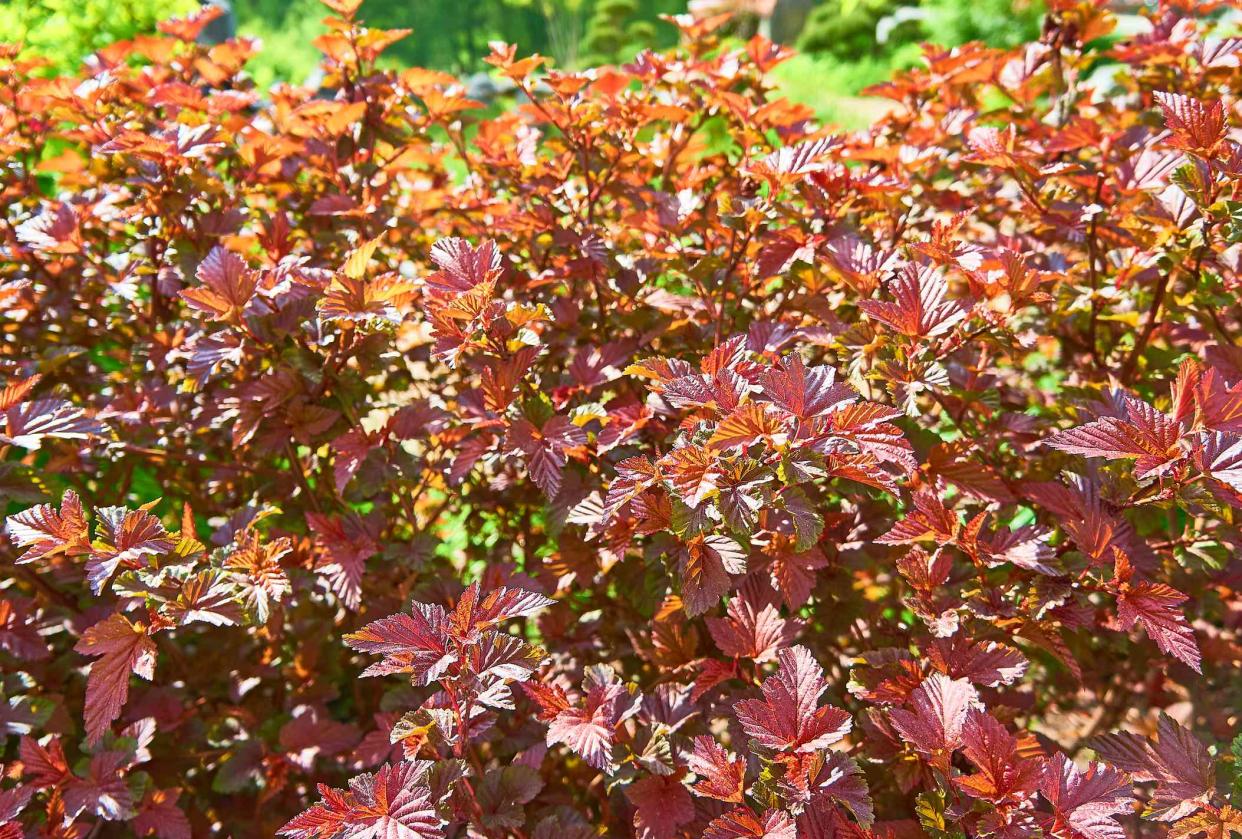
Elena Goosen / Getty Images
Reviewed by Andrew Hughes
Most shrubs planted in a landscape for ornamental purposes get their wow factor from blooms that captivate and draw a viewer’s interest. Other shrubs serve utilitarian purposes by creating screens or hedges that create windbreaks or privacy walls. Physocarpus opulifolius ‘Jefam’ AMBER JUBILEE or, simply, Amber Jubilee ninebark is different. The cultivar is chosen because it creates all-season interest with the beautiful colors its foliage produces from spring to fall and when the unusually attractive textured bark presents itself after leaf drop.
If you are considering a shrub that provides four-season interest, the Amber Jubilee ninebark provides a unique option not seen in many gardens.
Common Name | Amber Jubilee Ninebark |
Botanical Name | Physocarpus opulifolius 'Jefam' AMBER JUBILEE |
Family Name | Rosaceae |
Plant Type | Deciduous shrub |
Mature Size | 5 - 6 ft. tall, 3 - 4 ft. wide |
Sun Exposure | Full sun to Part Shade |
Soil Type | Average, dry to medium, well-drained. |
Soil pH | Adaptable |
Bloom Time | May to June |
Flower Color | Pink or white |
Hardiness Zones | 2-8 (USDA) |
Native Area | Patented Cultivar |
Amber Jubilee Ninebark Care
Sometimes shrubs require a ton of maintenance to keep them looking their best. If you want to avoid spending weekends pruning but still have a shrub that still dazzles, then Amber Jubilee ninebark might be just what you need. This particular cultivar is pretty easy to manage and requires very little pruning (though it looks better with a cut now and then).
The best part of this cultivar is how easy the overall care is. It might be the perfect shrub for a property owner who does not want to get too invested time-wise into their garden but still wants the wow factor that comes with great plant selection.
Light
Depending on the zone it is being planted in, the amount of sun an Amber Jubilee needs to receive may need to change some. The further north you plan to plant the shrub, the more sun it can and should receive. Ideally, it prefers full to part sun, but in a region where the summer temperatures and afternoon sun can become outright blistering, providing afternoon shade will make your ninebark very happy.
Soil
Amber Jubilee grows effortlessly in average soils that are well-draining, a little acidic, and that run dry to medium moist. With this being said, you can throw almost any soil type at this particular species, excluding sopping wet soil, and it will tolerate it and do well with little to no adverse effects on health or aesthetics. It does especially well in shallow, rocky, gravelly, clay, and soil prone to erosion.
Water
Another reason people love this shrub is how water-wise it becomes with maturity. When first planted, the Amber Jubilee will need extra watering, but once it becomes established, this hearty shrub can tolerate dry soils that would make other ornamentals shrivel. It can tolerate droughts well, too, but rather than accepting the stress the plant is under, giving it a drink every so often during dry weather to help compensate for the lack of rain.
Temperature and Humidity
Amber Jubilee does extraordinarily well in even the harshest conditions unless you count high heat and humidity. This hearty shrub will not thrive or do well in hot and humid areas, even with a large amount of shade and water. The best thing to do is to strictly follow the USDA hardiness zone map for its habitable range and not deviate from that to ensure the happiest and healthiest shrub. In the case of the Amber Jubilee, it demands being planted in USDA zones 2 through 8.
Fertilizer
It really is not necessary to fertilize an Amber Jubilee ninebark unless you notice it is suffering from some deficiencies. These might appear if you place the shrub in severely poor soil conditions. Before deciding to give your shrub a boost, it is best to determine that the soil is the culprit, at the very least, determine what nutrients your soil is lacking by testing the soil. You can do this with the help of a store-bought kit readily available at any garden center or hardware store.
When giving your shrub a boost, remember that the real beauty of the shrub is its foliage, so you will want to aim for a fertilizer that helps give the foliage a little kick. Do this by looking for a fertilizer with a higher nitrogen value in the NPK formula. Testing the soil first is essential, because improperly fertilizing with high nitrogen fertilizers increases the chance of fire blight infection.
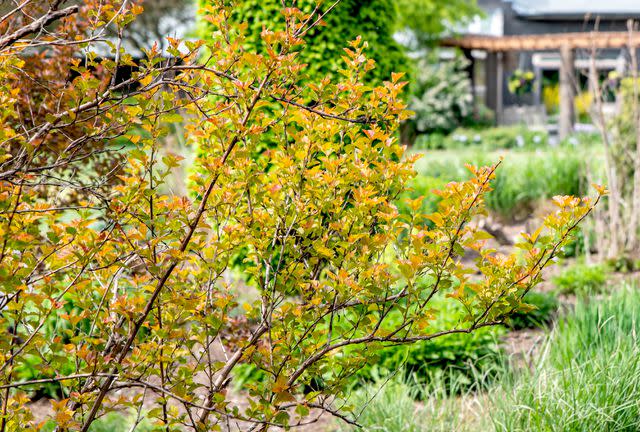
The Spruce / Adrienne Legault
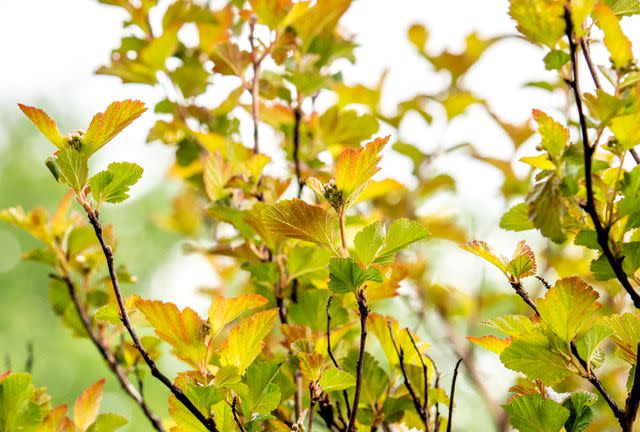
The Spruce / Adrienne Legault
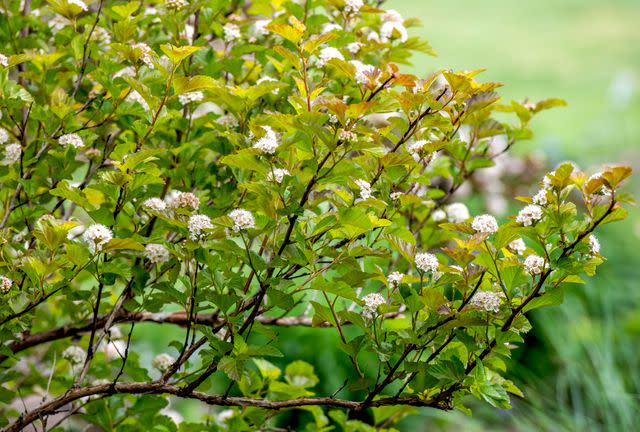
The Spruce / Adrienne Legault
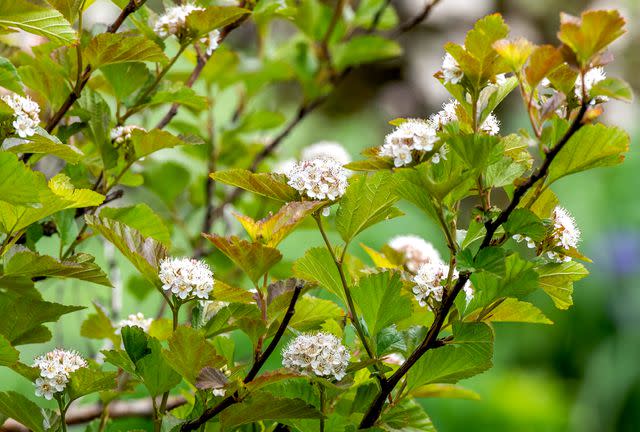
The Spruce / Adrienne Legault
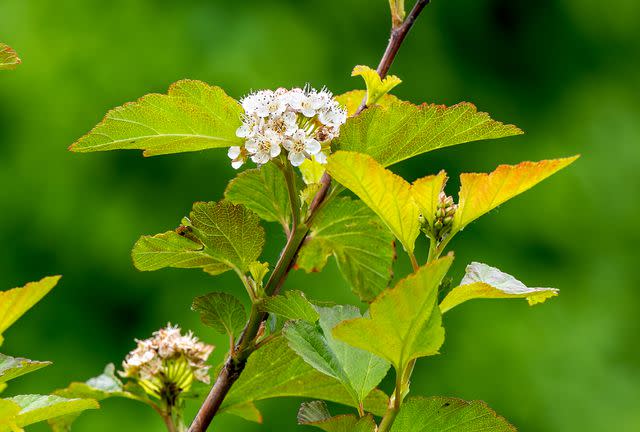
The Spruce / Adrienne Legault
Types of Amber Jubilee Ninebark
‘Jefam’ AMBER JUBILEE is a cultivar of the plant Physocarpus opulifolius, meaning you will not find any other types of ‘Jefam’ AMBER JUBILEE ninebark. Other cultivars of ninebarks are available, but they will all have wildly different characteristics than this cultivar.
This cultivar is actually patented, meaning that you cannot legally propagate it without a license. Secondly, its patented name, Amber Jubilee, refers to the color of its foliage and 2012, the year it was patented, which was also Queen Elizabeth II’s Diamond Jubilee.
Pruning Amber Jubilee Ninebark
The best way to leave your Amber Jubilee ninebark is in the natural-looking form it was intended to grow in. This means you will not need to do a lot of pruning, but that does not mean you might not have to prune at all. Depending on the size you want, you can prune yearly, which will encourage floral growth and keep the shrub smaller, or prune every three to five years to rejuvenate the shrub and encourage new growth, new foliage, and more attractive stems.
If you decide to do rejuvenating cuts every three to five years, the ninebark should be cut close to the ground during the winter months. If pruning for size yearly, the best time to do so is immediately after the last blooms die off but not too late in the summer. Pruning at the wrong time will cause your plant to slow its growth.
Common Pests & Plant Diseases
Not many pests irk the Amber Jubilee ninebark, which is yet another reason to consider it for your next landscape project. It does suffer from a few common diseases, but these are not too troubling and are easily controlled.
All ninebarks can be susceptible to fire blight, a disease caused by a bacteria called Erwinia amylovora. The symptoms appear over winter with cankers, and bacterial oozing, followed in the spring with foliage that looks waterlogged, then blackens and finally dies off. Fireblight can be controlled by pruning off infected areas and limiting high nitrogen fertilizer.
Another issue commonly seen but thankfully easily avoided and corrected is powdery mildew. If your shrub's foliage looks like it has been dusted with baby powder, there is a good chance it has been infected with the fungal disease powdery mildew. The best treatment is prevention. Planting is a sunny spot, not overwatering, and keeping garden tools clean will help you avoid this irritating disease. If the pathogen does get a hold of your plant, you can use fungicides to help slow the spread after removing all infected plant matter and properly disposing of the waste by burning it. Most importantly, thoroughly clean your tools afterward with bleach to kill the fungal pathogen to eliminate its spreading to other plants.
Frequently Asked Questions
How long do ninebarks live?
This cultivar along with all ninebarks are extremely long lived. They can easily live up to 100 years.
How fast do Amber Jubilee ninebarks grow?
All ninebarks grow relatively fast. They grow around 15 inches per year, but this depends on the conditions they are grown in.
Why is it called called ninebarks?
The ninebarks gets its name from what many consider its most attractive feature, its peeling bark.

